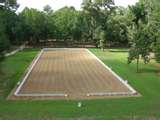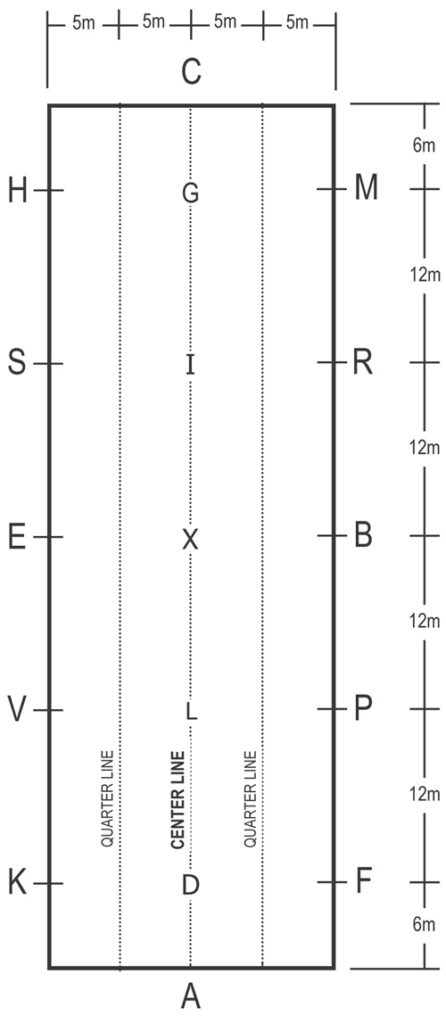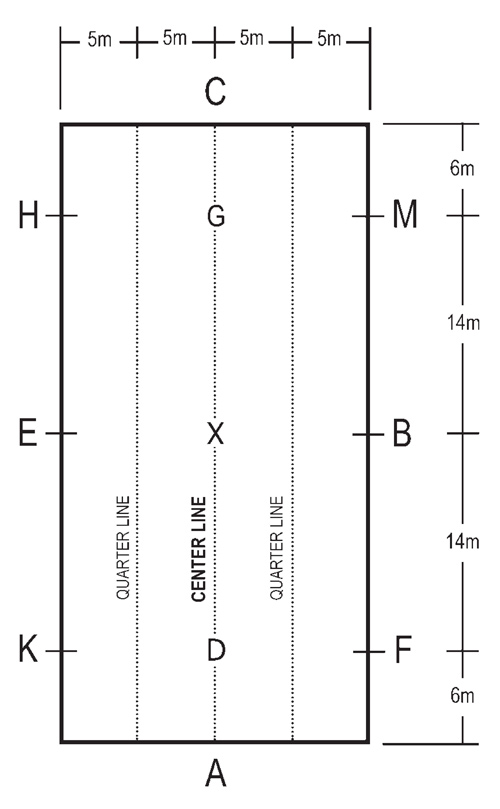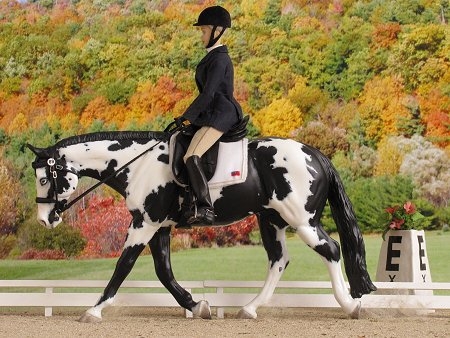IMEHA (International Model Equine Hobbyists Association) was an online photo showing site that existing until 2018. Included on the site were these guidebooks for judging and showing model horses in Performance classes. MEPSA has obtained permission to share the info contained in the guides.
Dressage is a French word whose definition literally means “Training”. By that definition it can be related to aerobics or gymnastics for the horse and rider. By the very nature of the work performed, dressage builds the “physique” of the horse through this training. The horse will become; attentive, supple, strong, flexible, loose, balanced, agile, powerful, coordinated, accurate and have greater stamina & endurance. The end goal is complete harmony of the horse and his rider, executing the highest level movements with precision, self carriage, balance, grace, harmony and control of power. The horse learns to have freedom & regularity of the gaits, flexion, balance, and lightness on the forehand, ease of movement, self carriage, engagement of hind quarters resulting in lively impulsion and acceptance of the bit without resistance or tension. The horse moves in balance at all times, he travels in a straight line when asked without crookedness. When performing curved lines he proceeds with balance and suppleness with the appropriate bend in the direction of travel but without falling in on his inner shoulder. In the instance where lateral work is called for he performs this as asked while traveling with straightness and the correct bend for the direction of travel. The horse obeys instruction from his rider willingly and without resistance or hesitation in a calm and precise manner. In all his work the horse must remain on the bit. Halts are square and on the bit at all times. In all work the horse is on the bit with the front of his face literally perpendicular to the ground (vertical or just in front of vertical), his poll being the highest point of his body at any moment during his work. Furthermore, the position of his head and neck relative to the ground will be higher as the levels proceed from lowest to highest. The self carriage, cadence and collection (or compaction & elevation & cadence) of his movements are relevant to the level of dressage training as well. The rhythm of the horses gaits and paces is considered to be fundamental to dressage, hoping or non-rhythmic paces are penalized.
The ability of any horse to compete at any level of dressage relies heavily on his conformation, physical strength as well as his mental ability to learn and his riders ability to teach him. Dressage is not limited by breed or color in any way. Competition dressage exists on many levels beginning with the Introductory Level, followed by Training Level, First through fourth Levels, Prix St. Georges, Intermediate Level and culminating with the Grand Prix Level. There are several less known and uncommon types of competition dressage and they are; the Quadrille, Pas de Deux and the Musical Free Style (or kur). Few competitions offer the Prix Caprilla which combines lower level dressage and several small obsticles for the horse to jump during his dressage test. This type of event is described elsewhere in the guide.
Competition:
Each competition entered is called a “test”. Each test is judged in small sections; called movements. The scoring system used to judge how well the pair perform on each movement runs from zero (not performed) to ten, (perfect). There are also weighted movements that count for double, triple and even quadruple points based on their importance and relevance during any particular test. At the bottom of every test there are scores called “The Collective Marks”. These scores measure several things, including; the quality of the horse’s paces (freedom and regularity), his impulsion (desire to move forward, elasticity of the steps, suppleness of his back and engagement of his hind quarters). Also in this section of scoring the test, double points are awarded for correct rider position, seat and correctness of and effectiveness of the aids. Double points are also awarded in this section for submission (attention, confidence, harmony, lightness, ease of movements, acceptance of the bridle (on the bit), and lightness on the forehand).
Most dressage shows offer competitors a variety of competition levels to enter. Each horse may not enter further than one level above the lowest level entered. In other words a horse entered in a training level test cannot show in second level. Likewise a horse shown at Grand Prix cannot show in Prix St Georges level. Each test is a series of specified movements performed at specific points in the arena. Outer letters/markers are posted outside of the arena fence, while others riders need to remember their placement as they are imaginary as shown in the diagrams below. The arena (ring) that these tests are performed in have a short fence or chain fence of various styles that surrounds them. Most have a removable gate at the letter “A” that is replaced into position by the gate keeper once the pair move into the arena. All tests begin by entering the arena at “A”. Judging of all movements begins when the pair enter the arena and end when they exit the arena. For complete rules as laid out by the USEF (United States Equestrian Federation) please see: USEF Rules
*Note: All photo’s used credited to the owner of the photo, photo’s of real horses credited at the end of the guide, all unmarked photo’s of model horses and tack belong to Beverly J. Lynch, Volte Equestrian Enterprises.
Tack required:
English saddle with stirrups and saddle pads (either shaped or squared). Style of saddle may vary with level performed. A dressage saddle should be used above Second Level. For FEI Training up until Fourth Level a plain snaffle bridle with leather noseband may be used (cavesson, dropped, flash or crossed noseband) that can be padded. Fourth and Fifth Levels may use the same equipment or substitute a simple double bridle with bridoon and curb with curb chain. FEI Tests require a double bridle for all tests. Leg bandages are allowed in Pax de Delux and Quadrille only. Breastplate and crupper are permissible. Prohibited tack is as follows: Martingales, tie downs, bit guards, side reins, running reins, any kind of boots or bandages except in previous mention tests, tail bandages, blinkers, ear muffs, nose covers, seat covers, hoods. Decorations in the tail such as flowers or ribbons are prohibited. Pelham bits are never allowed. For model horse a pelham is described by NAMSHA as: A bit with two reins but only one headstall, attached to the curb portion.
Sidesaddle riding is allowed but since IMEHA offers a Sidesaddle Division any sidesaddle dressage entry should show in sidesaddle division.
Turnout of Horse:
Braided manes and tails are permitted. Tails are left long, they can be banged or pulled too. Unbraided manes are short and pulled. Braids may be of any style, sewn or wrapped with white tape. Braided tails are uncommon in the USA. Military uniforms and tack is acceptable for qualifying rider. Black tack is currently fashionable. Saddle pads are usually square and white, sometimes black trim or piping is seen. Dressage rider tend to show in black and white.
Turnout of Rider:
- The dress code for Training through Fourth Levels is a short riding coat of conservative color, with tie, choker or stock tie, white or light-colored breeches or jodhpurs, boots or jodhpur boots, a hunt cap or riding hat with a hard shell, derby or top hat. A cutaway coat (modified tailcoat) with short tails is permitted. Half chaps, gaiters and/or leggings are not allowed. Gloves of conservative color are recommended. Exception: Riders through First Level may wear half-chaps, gaiters or leggings in solid black or brown, without fringe, matching the color of their boots, and made of smooth leather or leather-like material. The dress code for the FEI Junior Tests, FEI Dressage Tests for 4, 5, and 6-year-old horses and the USEF test for 4- year old horses is a short riding coat of conservative color, with stock or tie, breeches, hunt cap or riding hat with a hard shell, derby or top hat. A dark tailcoat is also permitted for the FEI Junior Tests. The dress code for FEI Pony Riders is dark coat or club uniform coat, breeches or jodhpurs, white shirt with tie or hunting stock, gloves, boots and hunting cap; top hat or bowler not allowed. Spurs are optional for all of the FEI Pony and Junior Tests, FEI Dressage Tests for 4, 5, and 6-year-old horses and the USEF test for 4-year old horses.
- For all tests above Fourth Level, the dress code is: a dark tailcoat with top hat, or a dark jacket with a bowler hat or hunt cap, and white or light colored breeches, stock or tie, gloves, and black riding boots. Spurs are mandatory for FEI tests (except as noted above under DR120.1). (See DR120.8)
- Members of the Armed Services and police units may ride in the uniform of their service at any level. Riders choosing to wear Armed Services or police uniform must wear the appropriate military/police cap or hat for their branch of service, or protective headgear.
- Riders at all levels of competition must wear one of the following: A hunt cap or riding hat with a hard shell, derby or top hat, military/police cap or hat, or protective headgear. Any exhibitor may wear protective headgear at any level of competition without penalty from the judge. Exhibitors choosing to wear protective headgear must wear a short, dark jacket, dark tail coat (only permitted for tests above Fourth Level), or Armed Services or police uniform (if eligible), dark hatcovers (where applicable) and must otherwise conform to DR120.
- One whip no longer than 47.2 inches (120 cm), including lash may be carried in all classes except USEF/USDF Championships, USEF National Dressage Championships, USEF High Performance Championships, USEF High Performance qualifying and selection trials, and observation classes. (Exception: Competitors riding sidesaddle may carry a whip no longer than 47.2 inches (120 cm), including lash, in USEF/USDF Championships.) One whip no longer than 47.2 inches (120 cm), including lash may be carried in all qualifying classes (including NAYRC and NAJC) unless such use is otherwise prohibited by FEI or Federation rules or selection procedures for the classes. An adjustable-length whip may not be carried by a mounted rider.
- In extreme heat and/or humidity in all classes including FEI classes at National Competitions, management can allow competitors to show without jackets. However, competitors must wear a regulation hat and solid white or very pale colored long or short sleeved shirt, without neckwear. T-shirts are not permitted. Members of the Armed Services or police units may wear summer uniforms.
- Competitors will be allowed to wear a hat cover and a transparent or conservative color rain coat in inclement weather.
- Spurs must be made of metal. The shank must be either curved or straight pointing directly back from the center of the spur when on the rider’s boot. If the shank is curved, the spurs must be worn only with the shank directed downwards. However, swan necked spurs are allowed. The inside arm of the spur must be smooth and one or both arms may have rubber covers. If rowels are used, they must be blunt/smooth and free to rotate. Only blunt/smooth rowels are permitted in USEF High Performance Championships, USEF High Performance qualifying and selection trials, and observation classes. Metal spurs with round hard plastic knobs on the shank are allowed. Dummy spurs with no shank are also allowed. Only blunt metal spurs, no longer than 1.5 cm are permitted for FEI Pony Rider tests. This restriction also applies to warm-up and training areas, as well as during competition. Offset spurs without rowels are permitted for riders having an appropriate Dispensation Certificate.
- Riders in USDF Pas de Deux and Quadrille classes are exempt from the dress code requirements of DR120.1-4, except that headgear and boots as required in DR120.1-4 must be worn. Riders must follow the dress requirements outlined in the USDF Rules and Guidelines for Quadrille Competitions and for Pas de Deux.
Required:
A description of either USEF, USDF or FEI sanctioned Level, Test and Movement should be presented along with the entry. If a musical freestyle or kur then the Name of the Music should be included. A portion of the dressage fence with a letter marker for the appropriate letter (s) required to recreate the movement.
Extra Credit:
Given for a copy of the entire test with the specific movement lightened. Make sure a horse saluting the judge a X is facing the judge HEAD-ON. A standing horse with a turned head is always at fault. Be sure the horse is performing the movement stated. Look for a number (black number on white background and cut in a circle or oval) is placed on the browband or pinned to the saddle pad. The number may be on either side.
Other Specifications and Notations:
Riders that look like they are falling off or could potentially fall off may be subject to negative points or elimination. Improper use of tack or equipment/attire for level shown may also result in negative points or elimination. Any visible safety threat to horse or rider may also cause negative points or elimination of your entry. Given for a copy of the entire test with the specific movement highlighted. Be sure the horse is performing the movement stated. Make sure a horse saluting the judge a X is facing the judge HEAD-ON. A standing horse with a turned head or horse that is not on the bit is always at fault. Look for an entry number (black number on white background and cut in a circle or oval) is placed on the browband or pinned to the saddle pad. The number may be on either side or both sides. To scale flower decorations or flowering pots shown on the outside of the arena fence should merit some extra credit. Correct depiction of the entries movement and level shown with proper tack appointments for the level shown, including correct fit of tack and attire with together, should merit extra credit. Correct rider position, head shoulders, hips and heel alignment as well as appropriate shoulder to elbow backwards ‘L’ forming a direct line from the riders elbow to the horse’s mouth should merit extra credit.
All other information regarding required equipment & attire, types of arena footing, the Gaits/Paces of the horse and other basic rules please see the Competition Dressage Overview tab at left. For specific information on the movements and requirements of each grouping of levels please click on the associated tab at left.
Molds Not Suited For Dressage:
Entering Dressage Informal Schooling Shows – Introductory Walk Trot Tests and Dressage All Others Awards, Horse Entering Horse or Exiting Arena, Etc. with your models that are not really suited for dressage
Molds that are not sculpted with the correct dressage frame or those that lack impulsion or engagement should be entered in either Dressage Informal Schooling Shows – Introductory Walk Trot Tests or in Dressage All Others Awards, Horse Entering Horse or Exiting Arena, Etc.
For example:
A standing model should go into the Dressage All Others Awards, Horse Entering Horse or Exiting Arena, Etc. with the comment of Horse has finished the test and is waiting for an award announcement.
It may also go into the same class with the comment the horse has entered the arena and has stopped in the center at the imaginary letter “X” where rider will salute the judge before starting the test.
If your horse is walking at a tempo not suited for Dressage you can enter the horse in this class and use the comment Horse has finished the test and is now exiting the arena.
A model that is incorrectly framed over the topline, not on the bridle, has the nose extended too far above vertical, is not engaged with the rear legs or lacks impulsion can be shown successfully in Dressage Informal Schooling Shows – Introductory Walk Trot Tests.
Dressage Premium Limitation:
The same photo may not be used in two different dressage classes at the same time. The horse may show in different classes but must have a separate photo for each class.
Examples of Dressage Entries

Navigator shown as a Chestnut Arabian Gelding – Polish, Egyptian, Crabbet blend and is a Tumlinson Soliantu by Cohen, Shown by Andrea Robbins with the comment: Grand Prix Freestyle Test. Entrant is performing Passage, approaching left turn at E set to John Lennon’s Imagine.

Sherman shown as a Grey Hanoverian gelding and is a Starlight Porcelain Hanoverian. Shown by Kim Jacobs with the comment: Level Four; Test 3; Maneuver 4 – medium trot H to K; Doll by K. & L. Jacobs; Props, tack, photo by K. Jacobs.
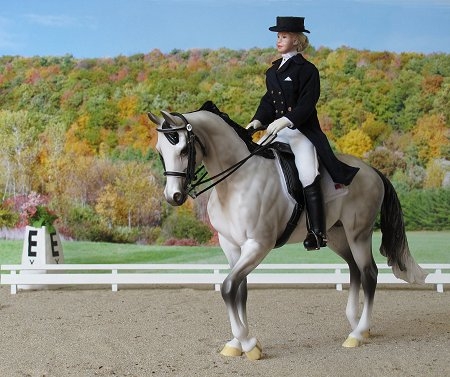
Moonlight on Silk shown as a Dappled Gray Thoroughbred Gelding and is a Stone TB Nazareth. Shown by Andrea Robbins with the comment: GRAND PRIX FREESTYLE DRESSAGE TEST: ENTRY DEPICTS: Horse and rider are performing a passage from S – X during the Grand Prix Freestyle Dressage Test set to Ravel’s Bolero.

